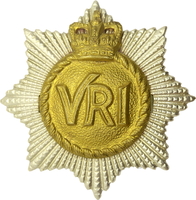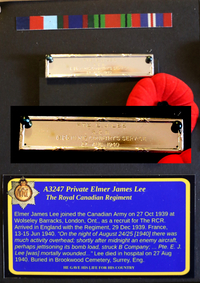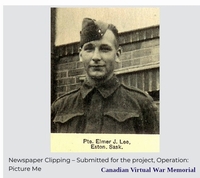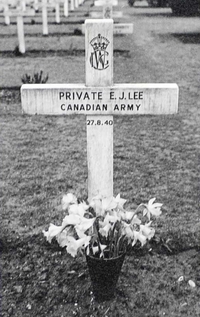
A3247 Private Elmer James Lee
The Royal Canadian Regiment
By: Capt (ret'd) Michael M. O'Leary, CD, The RCR
Elmer James Lee was born in Wichita, Kansas, U.S.A., on 25 Mar 1919. (Lee's attestation paper gives Brock, Sask., as his place of birth.) Lee's father, Elmer, died in February 1927 and Lee's mother, Ruth, moved to Canada when Lee was eight years old. Lee had one brother, John Franklin Lee, and a half brother from his mother's second marriage, Joseph Alfred Watson.
Lee attested for service in the Canadian Army during the Second World War on 27 Oct 1939. He enlisted at District Depot No. 1, Wolseley Barracks, London, Ont., as a recruit for The Royal Canadian Regiment. Living at 7 Dundas St., London, Ont., Lee gave his trade as mechanic. He identified his mother, Mrs. Ruth May Watson, Box 115, Eston, Sask., as his next of kin. Lee religious denomination was the United Church of Canada. He had no prior military service. On being taken on the strength of The RCR, Lee was posted to "C" Company of the Regiment.
Medically examined on enlistment and found to be in good health, Lee was placed in Category "A". He was described as 20 years 7 months of age, 5 feet 11 3/4-inches in height, weighing 173 1/2 pounds, with good physique, a 38-inch chest, dark complexion, blue eyes, and black hair. The doctor noted his appendectomy scar from an operation in 1930. He received a chest X-ray and vaccinations against typhoid and tetanus over the next few months.
The RCR concentrated its companies at Camp Valcartier in mid-November 1939 in preparation for proceeding overseas. While at Valcartier, Lee went A.W.O.L. from 0630 hrs to 1840 hrs on 29 Nov 1939. His punishment isn't recorded in the surviving pages of his file, perhaps it was a light award as it appears to be his first offence of any kind.
The Regiment left Valcartier under command of Lieut.-Col. V. Hodson on 17 Dec 1939, proceeding to Halifax to board theH.M.T. Almanzora, a Royal mail liner. On 21 Dec 1939, the regimental birthday, The RCR with 1,308 all ranks, sailed from Halifax. Disembarkation at Plymouth took place starting on 29 Dec and the Regiment proceeded to Aldershot.
Lee was granted leave from 5-9 Jan 1940 while the Regiment continued to train at Aldershot. Lee was briefly admitted to Connaught Hospital at Aldershot from 28 Feb to 4 Mar 1940.
On 7 Mar 1940, Lee qualified as a Driver (3rd Class). A few days later, on 10 Apr 1940, he completed a military Form of Will. In this will he bequeathed "All of [his] estate for her own use absolutely" to "(My Friend) Miss Beulah Hilda Aldworth, R.R. #1, Clear Creek, Ontario." She was also designated as Executrix for Lee's last will and testament.
On 13 Jun 1940, The RCR proceeded to Plymouth where the Regiment boarded theS.S. Elmansour. Reaching the coast of France early the next morning, the Regiment disembarked at Brest. Entraining, The RCR reached the area of Chateaubriant, Loire, France, about 300 kilometers inland, before they were ordered to return to the coast. The return journey to Brest was only accomplished because soldiers with railway experience in the unit were available to replace the French trainmen that abandoned their duty. Re-embarking at Brest on 15 Jun 1940, the RCR returned to Southampton by 17 Jun 1940.
Back at Aldershot, Lee was granted leave from 3-6 Jul 1940. A few days later, on 8 Jul 1940, he was A.W.L. again. Charged and found guilty, he was awarded seven days' Confinement to Barrack (C.B.) and forfeited one days' pay for the period he was absent.
The regimental history, The Royal Canadian Regiment; Volume Two, 1933-1966, G. R. Stevens, OBE, LL.D., 1967, briefly describes the night of 24 Aug 1940:
"On the night of August 24/25 there was much activity overhead; shortly after midnight an enemy aircraft, perhaps jettisoning its bomb load, struck B Company; Pte. G. E. Dowell was killed, Pte. W. McAllister and Pte. E. J. Lee were mortally wounded; two others were slightly injured.· On the 27th there were nine close range warnings. On August 30th five parachutists were captured in the Brigade area."
Lee was admitted to No. 9 Field Hospital on 24 Aug 1940, suffering from penetrating wounds on the lower lumbar region. The lacerated wounds included perforations of his colon and small intestines from bomb fragments and peritonitis (inflammation). He was transferred the following day to No. 15 General Hospital at Bramshott. His case notes included the comment that he was: "Wounded at approx. 2400 hours. Admitted complaining of severe pain in upper abdomen." (For which he had received morphine.) His condition on admission to No. 15 G.H. was: "Wound just above crest of left ilium posteriorly. Belly wall rigid and very (?). P. 84; B.P. 125/60."
In the December 1985 edition of Pro Patria (The Connecting File), a regimental journal of The Royal Canadian Regiment, Lee's death is mentioned in a letter from Colonel Strome Galloway, an officer of the Regiment in the Second World War. Titled "The First To Die In World War II," the letter included:
"Several months ago I visited Brookwood Cemetery, near the famous Bisley Ranges in Surrey, England. I have done this several times before, as an old pre-war friend of mine who enlisted in The Regiment in 1939 is buried there. He is Pte Wesley McAllister, one of our first two or three fatal casualties by enemy action in World War II. Wesley died as the result of wounds received when a German bomb fell on the battalion's bivouac area near the village of Charlwood on August 25, 1940. Pte George Dowell was instantly killed by the same bomb. Two days later, Pte Elmer J. Lee died, and he may have also died of wounds received on August 25, although I am not sure."
A letter in the next regimental journal, Pro Patria, Issue No. 86 (April 1986), by LCol J.K. Bell added details to the deaths of McAllister and Lee. An Editor's note informed readers that "LCol Bell, a Sarnia, Ontario native, was the Regiment's first Medical Officer overseas in WW II, arriving in England with the Regiment in 1939." Colonel Bell's letter explained:
"The December 1985 issue of "The Connecting File" has just arrived and I would like to adorn further Strome Galloway's "The First to Die in WW II". His facts are correct but there are further interesting items about this unfortunate incident that I would like to report, since I was MO of The Regiment from 1939 to 1941.
"In my opinion, the Luftwaffe on the night of 25 August 1940 mistook The RCR area for Gatwick Airport and dropped bombs in the fields where our men were asleep under camouflaged canvas.
"I proceeded to the RAP [Regimental Aid Post] immediately and soon four casualties arrived. Pte Dowell was DOA and his body was placed in my 15 cwt truck. My attention centred on the serious wounds suffered by Ptes McAllister and Lee. A message was sent to Brigade for an ambulance which took some time to arrive because of the distance involved. I demanded that McAllister be sent to the closest General Hospital which was in Redhill, as it was my opinion he would never make it to the Canadian Military Hospital. Pte Smith who had been sleeping between the deceased Dowell and McAllister must have been on his back because the bomb fragment took the end off of his big toe.
"After this flurry of duty I reported on the casualties to our CO, LCol "Uncle Bill" Hodson. One of my questions was for direction as to what I was to do with the deceased. All officers knew what to do "in action" but here we were in a civilized country and nobody knew the drill, as I believe this was the first case of a Canadian soldier losing his life due to enemy action in England. Therefore, it was not surprising that no one at Brigade knew the answer either. Next day CMHQ made a procedural decision for such cases and Pte Dowell was taken care of by the local Charlwood undertaker and subsequently buried in Brookwood Military Cemetery.
"The second lesson learned was that up to that time the RCAMC had neglected to give MOs the legal right to declare a person dead. This authority came about later."
On 25 Aug 1940, Lee's mother was sent a telegram from the Records Office in Ottawa notifying her of his condition. The body of the message read: "Regret inform you A3247 Private Elmer James Lee officially reported dangerously ill abdominal wounds further details follow when received."
Lee's general condition was reported as "much improved" on the morning of 26 Aug 1940. But by 1400 hours, he was described as "Patient much worse this p.m. Given transfusion and O2 started. Belly soft."
Elmer James Lee died at No. 15 General Hospital, Bramshott, Surrey, Eng., on 27 Aug 1940. An autopsy was performed to examine Lee's body after his death. The pathologist recovered a bomb fragment measuring approximately one-half by one-quarter inch which appeared to have caused all of the soft tissue damage on its path through his body. "As no other fragments were found it was believed that the bomb-fragment had entered posteriorly, ploughed along in left lateral gutter, perforating descending colon and small intestine and then entering abdominal wall again had lodges against iliac crest." This extensive damage plus the secondary effects, peritonitis and swelling of the liver, led to Lee's death.
On 27 Aug 1940, a second telegram was sent to Lee's mother, reading: "Deeply regret A3247 Private Elmer James Lee officially reported died of wounds August twenty-seventh further details follow when received." This telegram was followed by an official letter confirming Lee's death.
Lee is buried in Brookwood Cemetery, Surrey, Eng., (Plot no. 3A, Row C, Grave 1). The cemetery register for Brookwood reads: "LEE, Pte, Elmer James, A/3247. The Royal Canadian Regt., R.C.I.C.. 27th August, 1940. Age 21. Son of Elmer Franklin Lee and Ruth Mae Lee, of Eston, Saskatchewan, Canada. 3. C. 1."
The Ottawa Citizen edition of 27 Aug 1940 included the 14th Canadian Casualty List, which included the following statement:
"Three fatal casualties in the Canadian Active Service Force overseas were reported today in a casualty list issued by the Defence Department. Privates George Edward Dowell of London, Ont. and Wesley McAllister of St. Thomas, Ont. were reported killed. Private James Gorriee of Nanaimo, B.C.. was reported as dead. Private Elmer James Lee of Eston, Sask., is dangerously wounded."
The 15th Casualty List, printed on 4 Sep 1940, listed Lee among the dead.
Lee had an insurance policy (for education) with Prudential Insurance Company (International). After his death, the cash value of this policy was paid out to his mother, who used part of it to pay off outstanding debts that Lee had. For overseas service of 248 days, Lee was entitled to a War Service Gratuity of $157.72, which was assigned to his estate. Lee's personal effects, which had been gathered together by his Company, were checked and repacked by the Records staff of the Canadian Military Headquarters on 11 Oct 1940. These effects included:
- 1 Bundle letters, papers, etc.
- 1 Bundle notebooks.
- 1 Holdall containing:-
- 1 Can Silvo,
- 2 Cloths,
- 1 Can Boot Polish,
- 2 Toothbrushes,
- 1 Button Brush,
- 2 Boot brushes.
- 1 Leather belt.
- 1 Shaving brush.
- 1 New Testament.
- 1 Cigarette case with 1 cigarette.
- 1 Tin containing snapshots.
- 1 Tin tooth powder.
- 2 Bars soap.
- 1 Mirror.
- 1 Razor in case.
- 1 Shaving stick.
- 1 Box shaving soap.
- 1 Billfold containing license and papers.
- 1 Steel mirror.
- 2 Pkgs razor blades.
- 1 Bundle of cloths.
- 1 Comb.
- 1 Notebook with snaps and papers.
- 1 Woollen pullover sweater.
- 1 Sport shirt.
- 1 Pr canvas shoes.
- 1 Kit bag.
- 1 Kit bag lock.
For his service in the Second World War, Lee was eligible to receive the 1939-45 Star, the Defence Medal, the Canadian Volunteer Service Medal with Overseas Clasp, and the 1939-45 War Medal. These were despatched to his friend, Miss Beulah H. Aldworth, R.R. #1, Clear Creek, Ont., on 30 Mar 1950. Lee's mother, Mrs. Ruth May Watson, Box 115, Eston, Sask., would receive a Memorial Cross to commemorate his sacrifice. This cross was despatched to her on 9 May 1941.
There is one more document of interest in the archives of The RCR regarding Private Elmer Lee. Dated 20 Sep 1940 and signed by the Adjutant, Capt. T.M. Powers, the letter accompanied Lee's helmet which was sent to Wolseley Barracks in London, Ont., for the Regiment's museum. The text of Powers' letter reads:
"This helmet belonged to A.3247, Private Lee E.J., Headquarters Company, The Royal Canadian Regiment, one of the first three casualties of the "Second Great War".
"On the night of 26th August, 1940, at 0005 hrs., a German Medium Bomber flew over the area occupied by "B" Company, releasing a salvo of two five hundred pound and one two hundred and fifty pound bombs, in the vicinity of No.12 platoon area.
"The two hundred and fifty pound bomb landed about fifty feet away from the tent occupied by Private Lee who was attached to "B" Company, a M.T. driver.
"Two other occupants of the tent were A.3390 Private Dowell G.E. and A.3602 Private McAllister. W., who were also killed, the other occupant A.3400, Private Smith, R.E., being slightly wounded.
"It is requested that this helmet be deposited in our Regimental Museum."
An added note on the fate of the three soldiers who died was typed at the bottom of the letter:
"Pte. Dowell, killed.
Pte. McAllister died two hours later in hospital.
Pte. Lee died two days later in hospital. The helmet was actually lying at the head of his bed at the time of the explosion."
The state of the helmet on its return to London (likely damaged as otherwise it would probably have been salvaged and restored to use) and its whereabouts are currently unknown.
Pro Patria
Visit a randomly selected page in The O'Leary Collection (or reload for another choice):
- The O'Leary Collection; Medals of The Royal Canadian Regiment.
- Researching Canadian Soldiers of the First World War
- Researching The Royal Canadian Regiment
- The RCR in the First World War
- Badges of The RCR
- The Senior Subaltern
- The Minute Book (blog)
- Rogue Papers
- Tactical Primers
- The Regimental Library
- Battle Honours
- Perpetuation of the CEF
- A Miscellany
- Quotes
- The Frontenac Times
- Site Map
QUICK LINKS
The O'Leary Collection—Medals of The Royal Canadian Regiment
Newest additions:
![]()
![]() SB-12725 Private Henry "Hank" Ard
SB-12725 Private Henry "Hank" Ard ![]()
WIA at Hill 187, Died of Wounds in Japan
![]()
![]() 2355331 Lance Corporal Albert Lorking
2355331 Lance Corporal Albert Lorking
Wounded in action, later a War Amps representative.
![]()
![]() 4334 / 477996 Pte Isaac Hamilton Wilcox
4334 / 477996 Pte Isaac Hamilton Wilcox
Permanent Force, South Africa, and C.E.F.
![]()
![]() 477019 Private Harold Ashcroft
477019 Private Harold Ashcroft
Transferred to the Tunnelers.
![]()
![]() 734231 Private Clark D. Thompson
734231 Private Clark D. Thompson ![]()
The older Thompson brother, killed in action.
![]()
![]() 733849 Private Norman Parker Thompson
733849 Private Norman Parker Thompson
The younger Thompson brother; post-war service in the Special Guard.
![]()
![]()
![]() A305 / 400305 Private Andrew Walker
A305 / 400305 Private Andrew Walker ![]()
"Previously reported Wounded, now Killed in Action."
![]()
![]() 823298 Pte Thomas Patrick Steele, M.M.
823298 Pte Thomas Patrick Steele, M.M. ![]()
… for gallant conduct in the field …
![]()
![]() P13066 Sergeant Harold Thompson
P13066 Sergeant Harold Thompson
Instrumental Soloist for over 20 years of Canadian Army service.
![]()
![]() 9609 / 477728 Private Albert Edward Piper
9609 / 477728 Private Albert Edward Piper
"Arrived from England as a STOWAWAY …"




